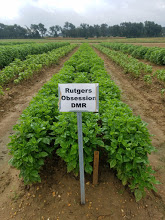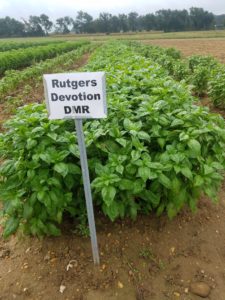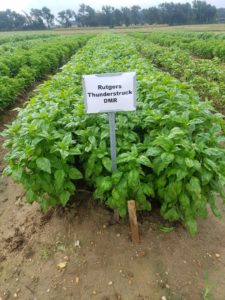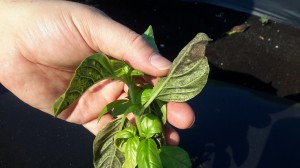Rutgers downy mildew resistant sweet basils available around the world; Research efforts continue
After a decade’s worth of research and breeding efforts Rutgers Downy Mildew Resistant (DMR) sweet basils are now available to commercial and organic growers as well as home gardeners around the world. Since 2007, when basil downy mildew (BDM) was first identified in FL, the disease has caused significant economic losses to commercial basil growers everywhere, and made growing sweet basil in the backyard garden nearly impossible. Basil downy mildew has commonly led to total crop loss for organic growers under field cultivation systems. The presence of any BMD on fresh leaves will make the product unmarketable. Of further concern is that the pathogen favors high relative humidity. Certain temperature range which can make a basil crop appear to be free of downy mildew (e.g., at times over the season or after a harvest when weather is too hot and dry), then full of disease upon arrival to the distributor or retailer because of the environmental conditions of the packaged basil during distribution and shipping which often favors its growth. Since 2009, Rutgers has been working diligently to identify and breed downy mildew resistance into commercially acceptable sweet basils that have the correct aromas, essential oils, and flavors. The first of these four new DMR sweet basils are available through your favorite seed company in North America, the European Union, and Australia.
Each of the new Rutgers DMR sweet basils have their own unique characteristics which can be matched to meet grower needs.
Rutgers Obsession DMR: An excellent sweet basil for field or potted plant production; will also make an excellent edible landscape plant; more compact, slower initial growth than Devotion DMR and Thunderstruck DMR, but for overall season is high yielding, lends itself to multiple cuts, and has a high leaf-to-stem ratio – good for small bunches or small size clam shells – dark green, thick, glossy leaves, flowers form very late; and highly resistant to Fusarium wilt.
Rutgers Devotion DMR: An excellent Genovese-type sweet basil for field production for fresh markets; establishes in the field or pots quicker than Rutgers Obsession DMR, with uniform, upright growth, dark, green color with flat to cup-shaped leaves. The Rutgers Devotion DMR is a beautiful plant.
Rutgers Thunderstruck DMR: An excellent sweet basil with high yields needed for processing- and fresh-market production; quick establishment and fast, upright growth with medium-sized, ruffled leaves with a bright green color.
Rutgers Passion DMR: An excellent sweet basil for potted plant and field production. Exhibits vigorous growth with high leaf-to-stem ratio; larger, slightly cupped leaf and similar aesthetics to Rutgers Devotion DMR.
Over the past 10 years, great research efforts have been made around the world to better understand and control basil downy mildew.
Understanding basil downy mildew
Basil downy mildew (BDM) is an obligate parasite, just like with all downy mildews, the pathogen needs a living host to survive. In northern regions, this means the pathogen will die out when basil crops freeze with the first frost in the fall. In areas of the south, such as southern Florida, the pathogen could survive year round as long as living basil is present. In greenhouse production (even in northern regions that freeze), as long as basil is in production the pathogen could be present. Research from Israel and Italy suggest that the pathogen can undergo sexual reproduction leading to the production of oospores, much like Phytophthora capsici, the causal agent of Phytophthora blight in pepper. This has profound effects on the pathogen – the opportunity to overwinter, develop new races, and its ability to develop fungicide resistance. For growers, this means that all downy mildew resistant basils still need to be grown with excellent management and with a proper spray program to ensure excellent control season-long.
Oospore production and overwintering
Oospore production via sexual reproduction in BDM has been confirmed in Europe, but not officially in the US to date. Oospore production suggests that mating types of the pathogen may be present. One early study from Israel showed that oospores were incapable of infecting plants. Importantly, oospore production in BDM could allow it to overwinter in soils drastically changing the way growers will have to manage the disease. Instead of waiting for BDM sporangia to arrive on your farm via weather patterns from other location or from infested seedlings, transplants, or plugs coming from more southern regions, the pathogen would already be present in your soil, and as long as weather conditions were favorable, the pathogen could cause disease. Thus, in more Northern regions, BDM could show up much sooner in the growing season. More work on understanding the role of oospore production in the lifecycle of BDM needs to be done. Growers must remain diligent and closely monitor their basil crop.
Basil downy mildew race development
Downy mildew pathogens in other cropping systems are known to develop new races over time. In spinach, for example, there are over 20 races of the pathogen. Importantly, the development of new races of the BDM pathogen would allow it to overcome current genetic resistance, meaning new genes for resistance would need to be bred into the host. In theory, for every new race of BDM that might develop, a new resistance gene or set of resistance genes would need to be bred into the host. Research in understanding the sweet basil genome as well as the pathogen’s genome is still in its relative infancy, but work at Rutgers and other Universities is currently ongoing. Understanding the genetic diversity of BDM in the US is a top priority of researchers with Rutgers collaborating with colleagues at UMASS, Cornell, and the University of Florida. Importantly, finding new sources of natural genetic resistance is also a top priority for all those involved in breeding for resistance to BDM. Research in each of these important areas to ensure continued genetic and plant breeding for basil downy mildew resistance is ongoing due to funds from the United States Department of Agriculture to the US universities listed.
Fungicide resistance development in BDM
Downy mildews in other crop systems are known to develop fungicide resistance. In recent years, mefenoxam insensitivity has been found in basil in Europe, but not the US to date. This suggests, along with knowledge of other downy mildew pathogens that fungicide resistance is most likely to develop in BDM. In recent years, a number of new fungicides with different modes-of-action have been registered for use in controlling BDM. Some of these fungicides have a high-risk for resistance development because of their active ingredient(s) and specific modes-of-action. Commercial basil producers need to take all the precautions to help mitigate fungicide resistance development. This means carefully following the use restrictions on the label and rotating among fungicides with different modes-of-action (e.g., rotating between fungicides in different FRAC codes).
Is basil downy mildew seed-borne?
Research has shown that BDM can be detected on the surface of seed using real-time PCR methods, but this method does not detect whether the pathogen is viable or not. Grow-outs of infested basil seed have been somewhat mixed; with some research showing it may be possible and others showing it is not possible. More work needs to be done and as such in the interim, it is better to assume it could be seed-borne.. For commercial growers and home gardeners, seed should always be purchased from reputable seed companies and growers should not harvest and save their own seed for possible re-infestation as studies have shown that BMD is detected on the seed collected from DMR and susceptible basil varieties. Some companies now offer propriety seed treatment methods for basil seed. When purchasing seed, you should ask if the seed has been treated and/or certified free of BDM.
Using BDM resistant sweet basils
In the past few years, along with the release of the new Rutgers DMR sweet basils, other sweet basils with BDM resistance have been commercially released in the US and Europe. It’s important for basil growers and homeowners to understand that none of the new DMR sweet basils are completely “immune” from getting BDM. The new DMR sweet basils are highly resistant to the pathogen compared to commercially-available susceptible varieties. Thus, in DMR resistant sweet basils the development of disease will be delayed – hopefully to much later in the growing season depending on your location, or not at all. Commercial and organic growers are encouraged to use DMR sweet basils along with best management practices, including appropriate fungicide use and good cultural practices, to help mitigate disease development.
For more information on basil downy mildew, our research, and our new Rutgers DMR sweet basils follow us on Instagram at RutgersBasil.




